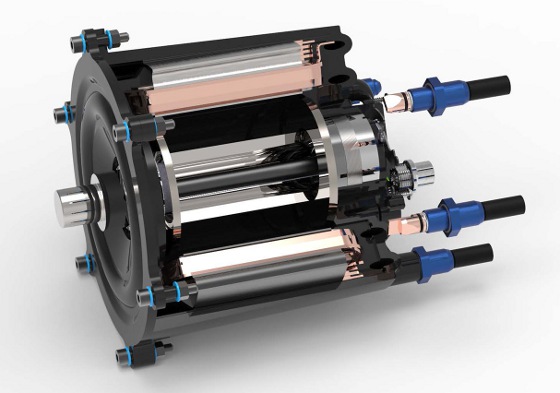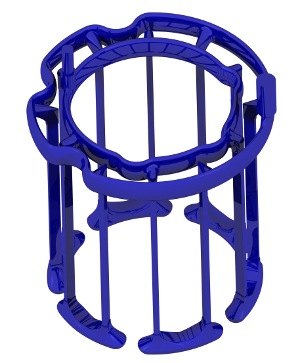 |
| April 23, 2019 | Volume 15 Issue 16 |
Designfax weekly eMagazine
Archives
Partners
Manufacturing Center
Product Spotlight
Modern Applications News
Metalworking Ideas For
Today's Job Shops
Tooling and Production
Strategies for large
metalworking plants
Wheels:
Electric vehicle motors closer to becoming mostly plastic
Lightweighting parts and systems is a trend that's here to stay, and motors for electric vehicles are no exception. It's all the better when dropping weight adds to function and performance through clever design. Take, for example, new motor technology being developed by researchers at the Fraunhofer Institute for Chemical Technology (ICT) in Germany. Their concept uses polymers as motor housing materials and employs plastics in an open stator that features a built-in coolant circuit. Besides being lighter, this design increases the power density and efficiency, too.

Sectional view of a new electric motor design that replaces many traditional metal parts with plastics. The core of the motor is a stator consisting of 12 individual teeth, which are wound upright using a flat wire. [© Fraunhofer ICT]
The two key components of an electric drivetrain are the electric motor and the battery. And there are three issues that play a particularly important role when it comes to using an electric motor for eco-friendly mobility: high power density, a compact configuration that fits snugly within the electric vehicle, and high levels of efficiency.
As part of the DEmiL project (a German abbreviation that stands for directly cooled electric motor with integrated lightweight housing), Fraunhofer researchers are now working with the Institute of Vehicle System Technology (FAST) and the Institute of Electrical Engineering (ETI) at Karlsruhe Institute of Technology (KIT) to develop a novel approach that incorporates direct cooling of the stator and rotor.
"An electric motor consists of a rotating rotor and a static stator," says Robert Maertens, a researcher at Fraunhofer ICT. "The stator contains the copper windings that the electricity flows through, and this is where the majority of electrical losses occur. The novel aspects of our new concept lie in the stator."
Electric motors are very efficient -- over 90 percent -- which means that a high proportion of the electrical energy is converted into mechanical energy. The remaining 10 percent or so of the electrical energy is lost in the form of heat. To prevent this particular electric vehicle motor from overheating, the heat in the stator is usually conducted through a metal housing to a cooling sleeve filled with cold water.
In this project, the researchers replaced the entire conventional metal housing and cooling sleeve with lightweight polymer materials. The main structure of the stator is made from polymer materials also. The rotor was not the main focus of the research, which is why it is a state-of-the-art permanent magnet rotor that is made from sheet metal and a metal rotor shaft. Maertens says they only used bearings and seals that are metal parts. In the stator of the motor, there are still a few metal components, which are required for electrical reasons: copper wire and sheet metal for the stator teeth.
The researchers have replaced the round wire with rectangular flat wire that can be wound more tightly in the stator. This creates more space for the cooling channel next to the flat wire winding phases.

Coolant circuit in the plastic stator. [© Fraunhofer ICT]
"In this optimized design, the heat losses can be dissipated through the cooling channel inside the stator, eliminating the need to transport the heat through the metal housing to an exterior cooling sleeve," says Maertens. "In fact, you no longer need a cooling sleeve at all. It offers other benefits, too, including lower thermal inertia and higher continuous output from the motor."
In addition, the new design incorporates a rotor cooling solution that also allows the rotor's heat loss to be dissipated directly within the motor.
By dissipating the heat close to where it is generated, the project partners were able to construct many of the main motor parts and housing from polymer materials, leading to further advantages.
"Polymer housings are lightweight and easier to produce than aluminum housings. They also lend themselves to complex geometries without requiring post-processing, so we made some real savings on overall weight and cost," Maertens says. The metal currently required as a heat conductor can be replaced by polymer materials, which have a low thermal conductivity compared to metals.
The project partners chose to use fiber-reinforced thermosetting plastics from their project partner SBHPP that offer high temperature resistance and high resistance to aggressive coolants. Unlike thermoplastics, thermosets do not swell when they come into contact with chemicals.
The researchers say the polymer housing is produced in an automated injection molding process using the phenolic molding compound Vyncolit X7700. The cycle time for manufacturing the prototypes is currently 4 min. The stators are overmolded with a thermally conductive epoxy resin molding compound (Sumikon EME-A730E) in a transfer molding process.
In the big picture, the researchers concentrated on creating an electric motor design and manufacturing process that is aimed at mass-production.
VIDEO: A new cooling concept for electric vehicle motors enables the use of plastics as housing material. Power density and efficiency of the drive are also significantly increased.
To date, the team has completed the stator assembly and experimentally validated the cooling concept.
"We used an electrical current to introduce the amount of heat in the copper windings that would be generated in real operation according to the simulation. We found that we can already dissipate over 80 percent of the expected heat losses," says Maertens. "And we already have some promising approaches for dealing with the remaining heat losses of just under 20 percent, for example by optimizing the flow of coolant.
"We are now at the stage of assembling the rotors and will soon be able to operate the motor on the test bench at the Institute of Electrical Engineering and validate it in real operation," Maertens adds.
Source: Fraunhofer Institute for Chemical Technology ICT
Published April 2019
Rate this article
View our terms of use and privacy policy
